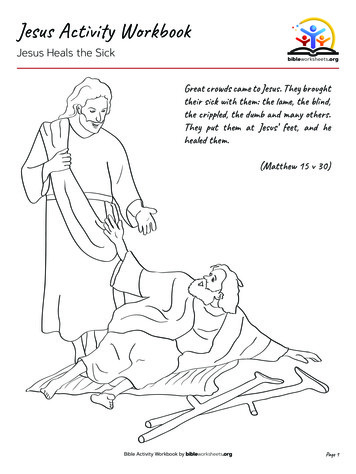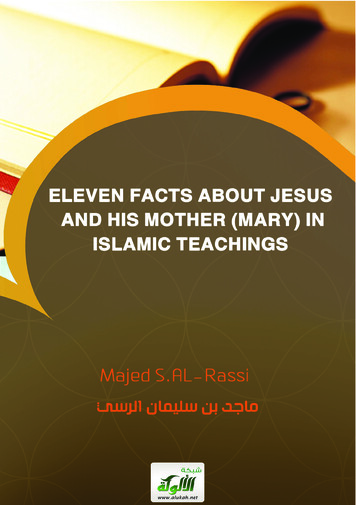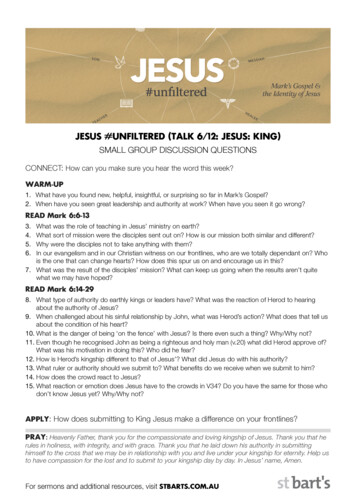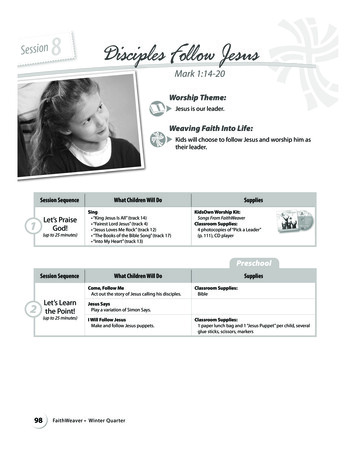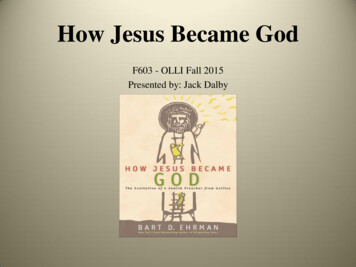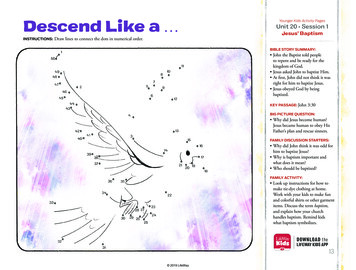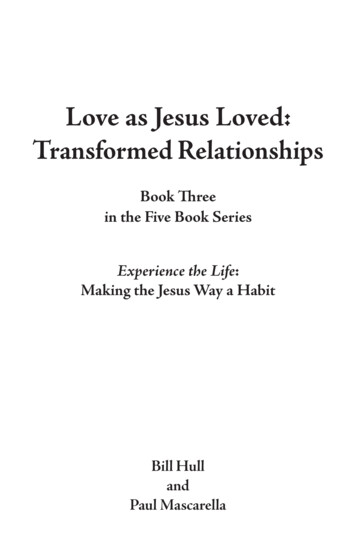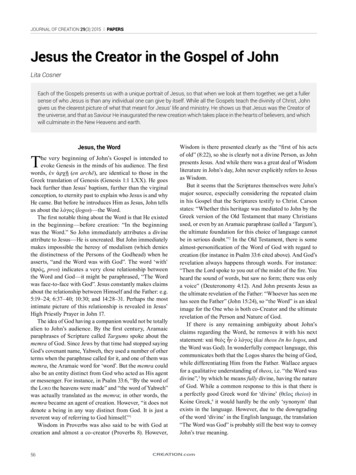
Transcription
JOURNAL OF CREATION 29(3) 2015 PAPERSJesus the Creator in the Gospel of JohnLita CosnerEach of the Gospels presents us with a unique portrait of Jesus, so that when we look at them together, we get a fullersense of who Jesus is than any individual one can give by itself. While all the Gospels teach the divinity of Christ, Johngives us the clearest picture of what that meant for Jesus’ life and ministry. He shows us that Jesus was the Creator ofthe universe, and that as Saviour He inaugurated the new creation which takes place in the hearts of believers, and whichwill culminate in the New Heavens and earth.TJesus, the Wordhe very beginning of John’s Gospel is intended toevoke Genesis in the minds of his audience. The firstwords, ἐν ἀρχῇ (en archē), are identical to those in theGreek translation of Genesis (Genesis 1:1 LXX). He goesback further than Jesus’ baptism, further than the virginalconception, to eternity past to explain who Jesus is and whyHe came. But before he introduces Him as Jesus, John tellsus about the λóγος (logos)—the Word.The first notable thing about the Word is that He existedin the beginning—before creation: “In the beginningwas the Word.” So John immediately attributes a divineattribute to Jesus—He is uncreated. But John immediatelymakes impossible the heresy of modalism (which deniesthe distinctness of the Persons of the Godhead) when heasserts, “and the Word was with God”. The word ‘with’(πρός, pros) indicates a very close relationship betweenthe Word and God—it might be paraphrased, “The Wordwas face-to-face with God”. Jesus constantly makes claimsabout the relationship between Himself and the Father: e.g.5:19–24; 6:37–40; 10:30; and 14:28–31. Perhaps the mostintimate picture of this relationship is revealed in Jesus’High Priestly Prayer in John 17.The idea of God having a companion would not be totallyalien to John’s audience. By the first century, Aramaicparaphrases of Scripture called Targums spoke about thememra of God. Since Jews by that time had stopped sayingGod’s covenant name, Yahweh, they used a number of otherterms when the paraphrase called for it, and one of them wasmemra, the Aramaic word for ‘word’. But the memra couldalso be an entity distinct from God who acted as His agentor messenger. For instance, in Psalm 33:6, “By the word ofthe Lord the heavens were made” and “the word of Yahweh”was actually translated as the memra; in other words, thememra became an agent of creation. However, “it does notdenote a being in any way distinct from God. It is just areverent way of referring to God himself.”1Wisdom in Proverbs was also said to be with God atcreation and almost a co-creator (Proverbs 8). However,56Wisdom is there presented clearly as the “first of his actsof old” (8:22), so she is clearly not a divine Person, as Johnpresents Jesus. And while there was a great deal of Wisdomliterature in John’s day, John never explicitly refers to Jesusas Wisdom.But it seems that the Scriptures themselves were John’smajor source, especially considering the repeated claimin his Gospel that the Scriptures testify to Christ. Carsonstates: “Whether this heritage was mediated to John by theGreek version of the Old Testament that many Christiansused, or even by an Aramaic paraphrase (called a ‘Targum’),the ultimate foundation for this choice of language cannotbe in serious doubt.” 2 In the Old Testament, there is somealmost-personification of the Word of God with regard tocreation (for instance in Psalm 33:6 cited above). And God’srevelation always happens through words. For instance:“Then the Lord spoke to you out of the midst of the fire. Youheard the sound of words, but saw no form; there was onlya voice” (Deuteronomy 4:12). And John presents Jesus asthe ultimate revelation of the Father: “Whoever has seen mehas seen the Father” (John 15:24), so “the Word” is an idealimage for the One who is both co-Creator and the ultimaterevelation of the Person and Nature of God.If there is any remaining ambiguity about John’sclaims regarding the Word, he removes it with his nextstatement: καὶ θεὸς ἦν ὁ λóγος (kai theos ēn ho logos, andthe Word was God). In wonderfully compact language, thiscommunicates both that the Logos shares the being of God,while differentiating Him from the Father. Wallace arguesfor a qualitative understanding of theos, i.e. “the Word wasdivine”,3 by which he means fully divine, having the natureof God. While a common response to this is that there isa perfectly good Greek word for ‘divine’ (θεῖος theios) inKoine Greek,4 it would hardly be the only ‘synonym’ thatexists in the language. However, due to the downgradingof the word ‘divine’ in the English language, the translation“The Word was God” is probably still the best way to conveyJohn’s true meaning.
PAPERS JOURNAL OF CREATION 29(3) 2015The Word as the agent of creationThe Word who reveals the FatherNot only does the Word exist alongside God the Fatherand share fully in the Divine Being, He works alongsidethe Father to accomplish what only God can do: “All thingswere made through him” (John 1:3). The New Testamentconsistently uses careful language to indicate that the Fatheris the Creator, and He created through the Son—i.e. the Sonis the agent of creation. “This way of putting it safeguardsthe truth that the Father is the source of all that is.” 5 AndJohn clarifies that Jesus acted in this way throughout theentire creation process: “and without him was not any thingmade that was made.” This also teaches that Jesus is nota created being, because He could not be an agent in Hisown creation!Furthermore, ἐν αὐτῷ ζωὴ ἦν (en autō zōē ēn, in him waslife). This claim is identical to what Jesus later claims in John5:26: “For as the Father has life in himself, so he has grantedthe Son also to have life in himself.” Mankind became aliving being only after God placed the breath of life in him,but the Word is self-existent, and His life is said to be whatenlightens men: “and that light was the life of men”.John returns to the logos imagery: “And the Word becameflesh and dwelt among us, and we have seen his glory, gloryas of the only Son from the Father” (1:14). The Word whowas the agent for the creation of all things entered into Hisown creation. And just as He brought the universe into beingin v. 3, He brought grace and truth into being in v. 17. Thesame Greek word, γίνομαι (ginomai), meaning to ‘become’or ‘come into being’, is used in both v. 3 and 17, as well as14, “became flesh”.The word “only” is the Greek μονογενής (monogenēs).The KJV translates this word “only begotten”, following theLatin unigenitus, with the presumed derivation from μόνος(monos), meaning ‘alone’ or ‘only’; and γεννάω (gennaō),‘to beget’. However, this does not fit the NT usage, e.g.Hebrews 11:17 refers to Isaac as Abraham’s ‘only begotten(monogenēs) son’, yet we know that Abraham begat othersons (Ishmael, and by Keturah). Rather, monogenēs isderived from γένος (genos), which means ‘kind’ (compare:‘according to kind’ in Genesis 1 (LXX) is κατὰ γένος (katagenos)). Thus monogenēs means ‘only one of a kind’ or‘unique’. Thus Isaac was the unique son of Abraham throughwhom the Abrahamic Covenant came. And Jesus is theunique son of God.The greatest claim about Jesus comes in v. 18: “No onehas ever seen God; the only God, who is at the Father’s side,he has made him known”. John called Jesus theos in v. 1, andmonogenes in v. 14; now He puts them together. The phrase“the unique God who is at the Father’s side” also expressesthe same idea of verse 1: Jesus is God, but distinct from theFather and in a close relationship with Him. Even though noone has ever seen the Father, Jesus reveals Him. This idea isbrought out even more strongly in John 14:8–9.Many places in the Old Testament feature people who seea vision of God, or the angel of the Lord. So how can Johnsay that “no one has ever seen God?” He gives us a hint in12:41: “Isaiah said these things because he saw his gloryand spoke of him”. But the Being Isaiah saw was calledAdonai (Isaiah 6:1) and Yahweh (6:3)—and John equatesHim with Jesus. So we can draw the conclusion that Johnviews theophanies from the Old Testament as visions of thepre-incarnate Son of God.The Light that came into the worldJohn’s next statement, “The light shines in thedarkness” (1:5), recalls Genesis 1:3; light was the first ofGod’s creations, whereas darkness is not a ‘thing’ in andof itself, but the absence of light. There are two possibleways to translate the next clause; either “and the darknesshas not overcome it”, as in the ESV, or “the darkness didnot comprehend it”, as the NKJV translates it. The lattertranslation fits the context of John being the witness to thelight. Also, John elsewhere uses the word νικάω (nikaō) tospeak about overcoming (John 16:33; 1 John 2:13, 14; 4:4;5:4, 5).John turns from the Word, or the Light, to talk about thewitness to the Light, John the Baptist. If we think about it,it may seem odd that the Light needs a witness. The onlyperson who needs a witness to light is someone who is blind,and that is precisely John’s point. The Light came into theworld, but the people to whom He came were blind. So theyneeded a witness, “that all might believe through him” (1:7).But most people did not believe: “The true light, whichgives light to everyone, was coming into the world. He wasin the world, and the world was made through him, yet theworld did not know him. He came to his own, and his ownpeople did not receive him” (1:11). We see examples of thisrejection and non-recognition throughout John’s Gospel,culminating in the crucifixion. However, John makes itclear that this rejection was not universal: “But to all whodid receive him, who believed in his name, he gave the rightto become children of God” (1:12).One week in the life of JesusJust as Genesis starts with a foundational week—thesix days of creation followed by God’s seventh-day rest—John also gives us a foundational week in the life of Jesus,culminating in the first of seven ‘sign miracles’. This sortof detailed chronological detail is uncommon in John, so heprobably did this on purpose.57
JOURNAL OF CREATION 29(3) 2015 PAPERSOn the first day, John the Baptist gives his testimony: heemphatically declares that he is not the Messiah, but insteadthe prophet preparing the way for the Messiah (1:19–28). Onthe second day, John identifies Jesus as the Messiah. On thethird day, John testifies about Jesus to two of his disciples,who then leave John and follow Jesus (1:37). They spent therest of the day with him (1:39), and the next day, Andrewintroduced Peter to Jesus (1:40–42). On the fifth day, Jesuswent to Galilee and called Philip and Nathanael. “On thethird day” (2:1), inclusively counting, places the wedding inCana and Jesus’ first sign on the seventh day.6Carson states:“This analysis is not grasping at straws. Only heredoes John provide a careful record of a sequence ofdays. . The week of days climaxing in the miracleat Cana may provide an echo of creation-week(Gn. 1). That means the miracle itself takes place onthe seventh day, the Sabbath. Jesus’ performance ofredemptive work on the Sabbath is later in this Gospel(5:16ff.; 7:21–24, 9:16) given the most suggestivetheological treatment in the New Testament, apartfrom Hebrews 4.” 7Turning water into wine is called Jesus first ‘sign’(σημεῖον, sēmeion; 2:11). John prefers this word to otherpossible synonyms, because Jesus’ miracles are never arbitraryor purposeless, but tell us something important about whoJesus is and the kingdom He is inaugurating. In John’s Gospel,a sign miracle is always followed by either a response ofbelief or unbelief on the part of the audience—in this case,“his disciples believed in him” (2:11). The responses of beliefand unbelief to Jesus’ teachings and actions are significantthroughout the Gospel, but especially so in response to thesign miracles.Jesus as the agent of a new creationIn John 3, Jesus tells Nicodemus about the new birth—acreative miracle performed by the Holy Spirit in those whobelieve in Jesus. Just as Jesus was the agent of the originalcreation, He is the agent for the new creation, beginningwith the spiritual regeneration of those who believe in Him.Nicodemus came to Jesus at the very beginning of Hispublic ministry. He had just cleansed the Temple; an actionthat Nicodemus, as a Pharisee, would not have been angeredby, and might even have approved (at that time the Templewas controlled by the ‘liberal’ Sadducees). Jesus wouldspend much of the rest of His ministry railing against thehypocrisy and legalism of the Pharisees, but theologically Hehad much in common with them, including belief in angelsand spirits and a future resurrection, which the Sadduceesdenied (Acts 23:8). Nicodemus’s comments in this sectionindicate that they had not yet made up their minds about58Figure 1. John manuscript P52, recto and verso. This second-centuryfragment disproved theories that John was written much later than theApostle John's lifetime.Jesus—they certainly had not started plotting against Himat this point.It is common to suggest that Nicodemus came to Jesusat night because of cowardice, but this is not necessarilythe case. Morris suggests that Nicodemus might simplyhave been exercising prudence, or simply practicality, bycoming at night:“Nicodemus was a prominent man; since he was‘Israel’s teacher’ (v. 10), it would never do to commithimself to the unofficial Teacher from Galilee, not atany rate until and unless he was absolutely sure of hisground. . The Pharisee may have chosen this timein order to be sure of an uninterrupted and leisurelyinterview. During the day Jesus would be busy andthere would be crowds (crowds of common people!).Not so at night. Then there could be a long, privatediscussion.” 8Nicodemus reports the consensus of at least some ofthe ruling class: Jesus is a teacher who has come from Godbecause of the miracles Jesus has done (John 2:23). But Jesuschallenges their idea that they have the ability to even evaluateHim; the expression, “Truly, truly, I say to you”, “serves todraw a contrast between Nicodemus’s opening statementand Jesus’ response. . Not human observation, reasoning,and ‘believing’ are required, but rather, a spiritual rebirth”.9This is not the answer Nicodemus would have expectedto hear, which may explain his overly literalistic response.Jews believed that they all would enter the kingdom of God,except for those who apostatized or committed some greatsin. Since their physical descent from Israel was thought tobe sufficient (an idea Jesus specifically refuted), he did notbelieve that the utter transformation of an individual was aprerequisite to participation in God’s kingdom.
PAPERS JOURNAL OF CREATION 29(3) 2015Jesus clearly believed that someone who set himself upas a teacher of Israel (“the teacher of Israel” may refer insome way to Nicodemus’s reputation as a great teacher inIsrael) should be able to understand what He is saying. Heinsists that the new birth is real, although invisible as thewind, and that it is an absolute necessity for anyone whowants to enter the Kingdom of God.Furthermore, Jesus claims first-hand knowledge of thetruth about which He speaks. He echoes the first-personplural Nicodemus used in his introductory comments:“Truly, truly I say to you, we speak of what we know, andbear witness to what we have seen, but you do not receiveour testimony” (3:11). In Jesus’ analysis, Nicodemus’sproblem is not misunderstanding, but simple unbelief.And this unbelief about something that should have beensimple for a ‘teacher of Israel’ to understand is a barrierto understanding the deeper truths that Jesus reveals tobelievers: “If I have told you earthly things and you do notbelieve, how can you believe if I tell you heavenly things?”(3:12). If Nicodemus doubts God’s work that takes placeon earth, how can he believe Jesus’ testimony about thingswhich occur in Heaven and thus are not observable? Carsonputs forward this interpretation: “The ‘heavenly things’ arethen the splendours of the consummated kingdom, and whatit means to live under such glorious, ineffable rule.”10Jesus is able to speak about these heavenly realitiesbecause He has descended from Heaven (3:13). And justas Moses lifted up the bronze serpent to give life to thosewho had been bitten by the serpents in the wilderness(Numbers 21:4–9), Jesus would be lifted up so that all wholook to Him in faith will receive the new spiritual birth.The “lifting up” (ὑψόω hypsōo) would eventually be back toheaven whence He came, but it’s clear from John 12:32–34that this hypsōo referred to being raised on the Cross.11If Nicodemus had a response to all this, John doesnot record it. Rather, Nicodemus disappears from thenarrative, to appear later in the Gospel (7:50; 19:39). Johninstead introduces his own commentary in 3:16–21. Mosttranslations see these as the continued words of Jesus, butthese verses have a clear post-Resurrection viewpoint, andJohn is careful not to impose that sort of anachronism in theevents of Jesus’ ministry.Jesus gives life by His wordIn John 4:46–54, Jesus heals an official’s son who wasat the point of death, simply by speaking. Jesus’ ability toproclaim the boy to be healed without touching or evenseeing the recipient of the healing was unique, and showsthat Jesus, the Word, has the ability to give life to whomeverHe wants.The official did not come with any notable faith. Rather,he seems to have come out of desperation, having heardthat Jesus was a great worker of miracles. Jesus rebukesthe Galileans in general as lacking faith, but seeking ‘signsand wonders’ (4:48). The man simply responds, “Sir, comedown before my child dies” (4:49). Jesus replies, “Go; yourson will live” (4:49). The father believed, indicating that hedid not share the general Galilean interest only in signs andwonders. John records that the son actually did become wellat the very moment Jesus said that he would live, resultingin the belief of the man’s entire household. So we see thatJesus performed a greater miracle than the man requested;he wanted physical life for his son, while Jesus gave spirituallife for his whole household.This miracle, as well as several others in John’s Gospel,are designated as ‘signs’. This shows that they were notspectacles in and of themselves, but they served to showhis divine nature and authority, and thus challenged therecipients of the signs to respond.Jesus’ divine power and authorityAfter recounting a miracle that resulted in belief, Johnturns to a miracle that did not. Apparently, there was asuperstition regarding the healing powers of the pool atBethesda (figure 2), and an invalid man had been waiting tobe healed there for 38 years. The man clearly believed thatthe pool was his only hope for healing—when Jesus askedif he wanted to be healed, the man could only think of theimpossibility of getting to the pool in time. Not impeded bythe man’s unbelief, Jesus summarily commands him to risewith his bed, which the man did.One would think that a miracle of this magnitude andpersonal importance would be met with instant gratitudeand belief. However, when the Jews confronted the man forcarrying his bed on the Sabbath, the man did not hesitateto tell them it was Jesus who told him to do it. And Jesus’own warning to the man indicates that he never had truesaving belief (5:14).When challenged about healing on the Sabbath, Jesussimply replied: “My Father is working until now, and I amworking” (5:17). In other places, Jesus cited a perfectlyacceptable, biblical reason for working on the Sabbath—to do good. Because it was lawful to break the Sabbathto rescue an animal from distress, arguing from lesser togreater, it was also lawful to break the Sabbath to relievea human’s distress caused by demon oppression. Becauseit was lawful to break the Sabbath to circumcise a babyboy, which was viewed in Judaism as a kind of completionof creation, it is lawful to break the Sabbath to completea person by physically healing them. The apostles, or any59
JOURNAL OF CREATION 29(3) 2015 PAPERSmere human who could do such things, would be able touse such an argument.But the way Jesus elaborates makes it clear that He claimsthe prerogative of working on the Sabbath for the very samereason God does. In Judaism there was a debate aboutwhether God obeys the Law He gave to Moses: specifically,does God work on the Sabbath? The Rabbinic conclusionwas that God must work continually to uphold the universe,but that He does not break the Sabbath by doing so, becauseHe does not carry anything beyond the permitted distance,He does not lift anything above His shoulders, and so on.Jesus’ argument is simple: He imitates His Father exactly,and His Father loves Him and has given Him authority. Tohonour one is to honour the other; to reject one is to rejectthe other. The truly startling claim to His audience wouldhave been: “For as the Father has life in himself, so he hasgranted the Son to have life in himself.” Jesus is basicallyclaiming to have the relationship with the Father that Johnlays out in his prologue.Just as the previous sign confirmed the man’s faith, aswell as that of his entire household, this sign confirmed thatneither the man nor the Pharisees had true faith in Jesus.Other times, a sign provokes the wrong positive response,which is also held to be a form of unbelief, as when thepeople at the feeding of the 5,000 wanted to make Jesusking by force.The man born blindAs the Gospel progresses, the Jewish leadership’sopposition to Jesus intensifies, and unbelief becomes thetypical reaction to Jesus, as much out of fear of the Jewishleaders as anything. One notable exception is the case ofthe man born blind. Healing a man born blind was thought,in Jewish tradition, to be a miracle that only the Messiahcould perform. Jesus’ use of mud made with dust and salivamay be intended to recall the creation of Adam out of dust.Like the man at the pool of Bethesda, the man wasignorant of Jesus’ identity—even more so, since he hadbeen blind when he was in Jesus’ presence before. But hehad faith that Jesus was from God—he told the Phariseesthat He was a prophet (9:17). This of course falls far shortof Jesus’ true identity, but it is impressive faith, especiallyconsidering that he must defy the Pharisees to make thisproclamation. Indeed, by the end of their interrogation, he iscalling himself a disciple of Jesus (9:27). When Jesus finallycomes to him and reveals Himself, the man worships Him,indicating true belief (9:38).Jesus restores life to LazarusIn the other Gospels, Jesus raised Jairus’ daughter and theson of the widow of Nain, but the only raising John records isthat of Lazarus, and in many ways it is the most impressive.Jesus had a close relationship with Lazarus and his sistersMary and Martha, but when they sent for Him, He waiteduntil Lazarus was already dead before He even set out. Bythe time He arrived, decay would have set in. But Jesusraised Lazarus with a command (again, giving life by Hisword). Many believed in Him when they saw the miracle,but the Jewish leadership was only more determined to killJesus, and Lazarus too.The Creator sacrificedFigure 2. The ruins of the pool in Bethesda where Jesus healed the manwho had been lame for 38 years60The allusions to creation are more veiled once PassionWeek begins, because the focus turns to the meaning of theCross. However, in the high priestly prayer (John 17:1–26),we get a glimpse of the interaction between the Father andthe Son. Jesus has elsewhere insisted that He and the Fatherare absolutely unified, and we see the intimate fellowshipwithin the Trinity in Jesus’ prayer.
PAPERS JOURNAL OF CREATION 29(3) 2015Jesus knows His hour has come, and understands thegreat significance of it. At this critical moment, His concernis to glorify the Father—yet He also asks, “And now, Father,glorify me in your presence with the glory I had with youbefore the world existed” (John 17:5). It would be insaneand blasphemous to ask to share glory with God if Jesuswere not actually God, because God shares his glory withno one else (Isaiah 48:11). There is also a claim to havepre-existed Creation; an idea that John introduced in hisprologue. Jesus’ request shows that the Incarnation involved‘emptying’ Himself of His divine glory by adding humannature (Philippians 2:7). In His resurrection, His humanbody was resurrected and glorified, and He took on an evenadded dimension of glory as the Saviour of mankind.In addition, Jesus prays, “Father, I desire that they also,whom you have given me, may be with me where I am, tosee my glory that you have given me because you loved mebefore the foundation of the world” (17:24). This points backto the perfect fellowship and love shared by the membersof the Godhead. There is no ‘competition’ among them forglory. Jesus delights in glorifying His Father, and the Fatherdelights in glorifying the Son.Verses later, John records the arrest of Jesus and, asthroughout the rest of the Gospel, Jesus is portrayed asbeing in complete control. Jesus steps forward from thegroup of disciples and addresses the mob, and when hesays ego eimi—a possible allusion to the divine name (cf.Exodus 3:14)—the reaction of the mob is to withdraw andfall to the ground. Carson believes this falls short of atheophany,12 but most commentators see some significanceto the language. Jesus must repeat Himself, and the secondtime he commands them to let his disciples go.When Jesus was being mocked before the crucifixion,part of the degrading involved being mocked as the Kingof the Jews, crowned in thorns (19:2). While it is uncertainif this is a conscious reference to the Curse of Genesis 3:18on John’s part, it is fitting that the Last Adam should becrucified wearing a symbol of the Curse.impart spiritual life to his disciples because He successfullyatoned for their sin.Conclusion—Jesus, Creator and SaviourJohn’s Gospel consistently portrays Jesus as the Creator,with creative power and authority that belongs only to God.And He portrays Jesus’ mission in the Incarnation in termsof inaugurating a new creation through His atoning deathand resurrection. Those who believe in Christ receive anew birth, making Christians part of the new creation(2 Corinthians 5:17), and preparing us for the futureKingdom of God in the restored world.References1. Morris, L., The Gospel According to John, p. 106, NICNT, Eerdmans, GrandRapids, MI, 1995.2. Carson, D.A., The Gospel According to John, p. 115, Pillar New TestamentCommentary, Eerdmans, Grand Rapids, MI, 1991.3. Wallace, D.B., Greek Grammar Beyond the Basics, Zondervan, Grand Rapids,MI, p. 269, 1996.4. Carson, ref. 2, p. 117, and Kostenberger, ref. 9 (below), p. 28 make thisargument.5. Morris, ref. 1, p. 71.6. Morris, ref. 1, p. 156.7. Carson, ref. 2, p. 168.8. Morris, ref. 1, p. 187.9. Kostenberger, A.J., John, Baker Exegetical Commentary on the NewTestament, Baker Academic, Grand Rapids, MI, p. 122, 2004.10. Carson, ref. 2, p. 199.11. Carson, ref. 2, p. 201.12. Carson, ref. 2, p. 578.The Resurrected CreatorOnly John gives the detail that there was a garden whereJesus was crucified (19:41). The first man, Adam, sinned ina Garden, and the last Adam atoned for sin in a garden andwas entombed there. Mary Magdalene initially mistook theresurrected Lord for the gardener, a possible allusion to thevocation of the first man (20:15).When Jesus first appeared to the disciples after theResurrection, He breathed on them and said, “Receivethe Holy Spirit” (20:22). This is analogous to when Godbreathed life into Adam (Genesis 2:7). Jesus was able toLita Cosner earned a B.A. in Biblical Studies (OklahomaWesleyan University) and an M.A. in New Testament(Trinity Evangelical Divinity School). Her Master’s Thesisis Jesus the Honorable Broker: A Social-ScientificExegesis of Matthew 15:21–28. She is CMI’s full-timeInformation Officer in the United States office.61
speak about overcoming (John 16:33; 1 John 2:13, 14; 4:4; 5:4, 5). John turns from the Word, or the Light, to talk about the witness to the Light, John the Baptist. If we think about it, it may seem odd that the Light needs a witness. The only person who needs a witness to light is someone who is blind, and that is precisely John's point.

